Republic’s The Crimson Ghost
Enter now to win a copy of
Cowboys, Creatures and Classics: The Story of Republic Pictures
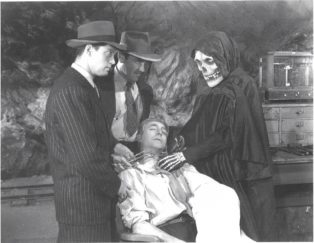
Scene from the Crimson Ghost – 1946
Moviegoers throughout the 1930s and 1940s enjoyed film adventures from heroes on exotic animals to those in space crafts. Such was the case with The Purple Monster Strikes, the original Republic Martian invader serial. The Purple Monster was actually not a monster at all, nor was he purple. The villainous character was in reality a Caucasian, Martian space soldier. He was part of the advance guard preparing a vast invasion of earth, dressed in a blue, tight-fitting outfit, trimmed with scaly gold metallic material, and wearing a matching gilded hood. Among the Purple Monster’s alien abilities was the power to become a transparent phantom and enter the body of another, controlling his actions, thereby donning the ultimate disguise.
The Purple Monster Strikes was the first post-war serial of 1945. Republic was prohibited from using the term “rocket ship” when referring to the spacecraft the Purple Monster used in the film. Universal Studios had a copyright on the word which was used quite extensively in their serial Flash Gordon.
Billed as 1941’s “sensational serial surprise,” Republic introduced a chapter play that combined monsters designed to take over space with earthly fiends. Entitled The Mysterious Doctor Satan, the villain is a mad scientist who wants to rule the world and planets from other galaxies with an army of mechanical monsters. Audiences were treated to fifteen shivering, shuddering, surprising episodes of Dr. Satan manipulating the hideous robots he creates to rob and terrorize the nation into submission. Dr. Satan’s sworn enemy is a beefy man in a copper mask appropriately known as Copperhead. Copperhead assumes the identity from his deceased father who was a fugitive from crooked justice in the Old West. The misunderstood hero is determined to protect society from the depredations of Dr. Satan, and, at the same time, wipe out the stigma attached to the name Copperhead.
According to Jack Mathis’ book Valley of the Cliffhangers, The Mysterious Doctor Satan was intended to be a series that would feature Superman as the fighter against evil. At the last moment, DC Comics, the owners of the Superman character, refused to let Republic use the radio and comic series star. Instead of abandoning the project, the writers replaced Superman with Copperhead, a character of their own creation.
A popular character Republic Pictures was allowed to introduce in one of its chapter plays was Captain Marvel. Also known as Shazam, the superhero was created in 1939 by artist C. C. Beck and writer Bill Parker for Fawcett Comics. Captain Marvel was the most popular comic book superhero of the 1940s. He was also the first to be adapted into film. The film was entitled Adventures of Captain Marvel.
In an interdepartmental memo passed from various executives at Republic to Herbert Yates, the project was touted as having “massive potential to be a box office hit.” The twelve-part series premiered in March 1941.
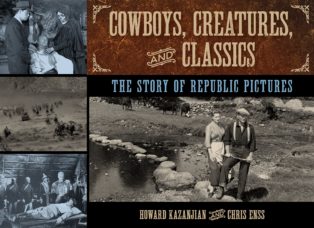
To learn more about the many films Republic Pictures produced read
Cowboys, Creatures and Classics: The Story of Republic Pictures
This Day…
Republic’s Captain Marvel
Enter now to win a copy of
Cowboys, Creatures and Classics: The Story of Republic Pictures
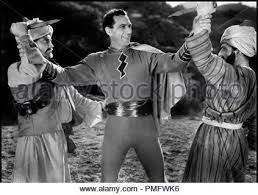
A popular character Republic Pictures was allowed to introduce in one of its chapter plays was Captain Marvel. Also known as Shazam, the superhero was created in 1939 by artist C. C. Beck and writer Bill Parker for Fawcett Comics. Captain Marvel was the most popular comic book superhero of the 1940s. He was also the first to be adapted into film. The film was entitled Adventures of Captain Marvel.
In an interdepartmental memo passed from various executives at Republic to Herbert Yates, the project was touted as having “massive potential to be a box office hit.” The twelve-part series premiered in March 1941. The plot of the chapter play was described in the following way:
To a remote section of Siam, jealously guarded by unconquered native tribes, comes the unwelcome Malcolm Scientific Expedition seeking knowledge of the ancient Scorpion Dynasty. Billy Batson, assistant to a radio expert, is the only one of the parties who does not enter a forbidden chamber. As a result, he is awarded the power to transform himself into a superman, Captain Marvel, upon uttering the word “Shazam.”
After a dozen spine-tingling chapters, Billy is bound and gagged so he cannot utter the word. He tricks the Scorpion into releasing the gag in order, as he pretends, to explain to him the secret of his invulnerability. Once released, he cries, “Shazam” and becomes Captain Marvel. He is able to free himself and his friends and expose the Scorpion once and for all.
Adventures of Captain Marvel was a huge success for Republic Pictures. Critics called the production “roaring good entertainment.” Many film aficionados consider the serial to be the best ever made.
The collaboration between Republic Pictures and Fawcett Comics continued after the release of the Captain Marvel serial. In 1942, the two entities brought the character Spy Smasher to the screen. Spy Smasher is a costumed vigilante and freelance agent who battles a Nazi villain known as the Mask. The Mask heads a gang of saboteurs determined to spread destruction across America. According to author and film historian Alan G. Barbour, the Mask was the first in a long line of stereotypes that pictured hard-faced Nazis as propagandist tyrants.
Spy Smasher was a twelve-part serial that was shot in thirty-eight days. Production began on December 22, 1941, just a few days after the Japanese bombing of Pearl Harbor. The Spy Smasher wore a cape, leaped from bridges onto fast-moving cars, outgunned Nazi devils, and escaped from all types of death traps, from burning tunnels to compartments slowly filling with water. Spy Smasher used a number of gadgets, among them being various laser beams and his fire-resistant cape, to foil the Nazis’ plans.
Daredevils of the Red Circle was a twelve-part serial that included a cape-wearing villain. The suspenseful, spine-tingling, mystery film told the tale of diabolical mastermind Harry Crowel, a.k.a. Prisoner 39013. Crowel escapes from prison and, aided by a seemingly endless supply of henchmen, sets out to destroy all holdings of industrialist Horace Granville, the man who put him in prison. One target is an amusement park, home of three Daredevils of the Red Circle who perform death-defying stunts. When head Daredevil Gene’s kid brother is killed in Crowel’s attack, the three heroes swear to capture Prisoner 39013. Unbeknownst to them, he is holding the real Granville captive and, with a near perfect disguise, has taken his place. A mysterious cloaked figure known as the Red Circle aides the daredevils in their crusade.

To learn more about the many films Republic Pictures produced read
Cowboys, Creatures and Classics: The Story of Republic Pictures
This Day…
Republic’s Catman of Paris
Enter now to win a copy of
Cowboys, Creatures and Classics: The Story of Republic Pictures
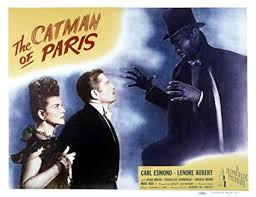
In April 1946, thrill seekers were looking forward to the release of The Catman of Paris. The gruesome mystery melodrama involved a man suffering from a loss of memory who was accused of being a feline killer operating in Paris.
The tagline read: “Walks like a man. Attacks like a cat. Who is the Catman of Paris.” The plot involved author Charles Regnier returning to 1896 Paris after exotic travels, having written a best seller that the Ministry of Justice would like to ban. That very night, an official is killed on the dark streets . . . clawed to death! The prefect of police suspects a type of cat, but Inspector Severen thinks there is nothing supernatural about the crime and thinks Regnier is responsible for the murder. Regnier denies he had anything to do with the crime but begins to doubt himself when he has a hallucinatory blackout during a second killing.
Vienna-born stage actor Carl Esmond played the troubled author Regnier. Lenore Aubert, the female lead in the movie, was also from Vienna. The press packet Republic Pictures circulated to theaters and media across the country contained plenty of information about the film as well as background information about the picture’s stars. Aubert’s story of how she made it from Vienna to Hollywood could have been a movie on its own.
According to the November 8, 1946, edition of the Mount Carmel Item, the actress had just finished making her third movie when the Nazis occupied her homeland. She and her mother fled to France where they hoped to begin a new life. There she continued studying and acting for a year until the downfall of Paris.
“The experience Miss Aubert underwent in getting from France, through Portugal, to Spain would alone defeat most people,” the Mount Carmel Item article read. “However, Miss Aubert realized her one hope for happiness could be found in America. After six months of ceaseless efforts, she was able to get a priority on a Portuguese boat.”
Critics were complimentary of Aubert’s performance and the film itself, calling both “satisfying” and “entertaining.”
Chills, thrills, suspense, and murder awaited moviegoers who dared to see Valley of the Zombies starring Republic’s contract players Robert Livingston and Lorna Gray. Debuting in May 1946, the film was about a prominent brain surgeon who is killed; law enforcement suspects the culprit was his associate Dr. Terry Evans. Doctor Evans and his sweetheart nurse embark on a quest to prove his innocence. In trying to clear himself, the doctor and his girlfriend visit hospitals, morgues, embalming establishments, and an eerie estate where a few more murders have been committed for good measure. While searching the estate, the doctor and nurse happen onto a gruesome figure that is a zombie. The zombie’s condition can only be reversed with large quantities of blood. The caretaker of the undead individuals traverse the woods and mental hospitals at night looking for unwilling blood donors.
Directed by Philip Ford, nephew of award-winning western director John Ford, Valley of the Zombies was void of any valleys and, apart from one undead creature, any zombies. It was a picture that was produced quickly to cash in on the zombie craze.

To learn more about the many films Republic Pictures produced read
Cowboys, Creatures and Classics: The Story of Republic Pictures.
This Day…
Republic’s Jungle Girl
Enter now to win a copy of
Cowboys, Creatures and Classics: The Story of Republic Pictures
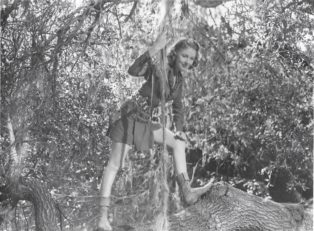
Zombies of the Stratosphere was one of three movies Republic produced dealing with a Mars invasion. Another profitable serial the studio made was Panther Girl of the Kongo. When wildlife photographer Jean Evans discovers a giant crab-like creature in the jungles of southern Africa, she sends word to a big game hunter and friend Larry Sanders for help. The pair soon learn these large crustaceans are the work of a mad scientist who wants to scare the population away from the area to operate a diamond mine. Jean, nicknamed the Panther Girl by the tribal locals because she shot a panther that had been terrorizing the village, and Larry are determined to find the mad scientist and stop him. Along the way, the pair must battle oversized sea urchins, wild animals, creepy henchmen, and inclement weather. They must survive gun battles, falls into quicksand, the roaring rapids, poison darts, and angry gorillas.
Panther Girl of the Kongo starring Phyllis Coats was the most expensive serial Republic Pictures produced in the 1950s. A great deal of footage used to make this film had been originally shot in 1941 for the movie Jungle Girl. Frances Gifford, the star in Jungle Girl, was the first female lead in a Republic serial, and Phyllis Coats was the last female lead in a Republic serial. In fact, Phyllis Coats wore the same outfit in Panther Girl that Frances Gifford wore in Jungle Girl.
The director of Jungle Girl was studio favorite William Witney. From 1935 to 1956, Witney practiced the philosophy Herbert Yates taught which was “make em’ fast and make em’ cheap.” Witney was a specialist in outdoor action and stunt direction. He directed or co-directed more Republic serials than any other company hire. He is considered the greatest action director in B movies.
Witney traveled to Los Angeles from Lawton, Oklahoma, to visit his sister and brother-in-law in 1933. His brother-in-law was a director for Mascot Pictures, and he got Witney a job at the studio as an office boy. After Mascot merged with Republic in 1935, Witney was promoted to script clerk and then to film editor.
In 1937, while Witney was working in Utah on a western serial, the director was fired, and twenty-one-year-old Witney was asked to take his place. Witney went on to direct the studio’s principal western, science fiction, and horror serials. From the Drums of Fu Manchu to the Mysterious Doctor Satan, he was able to masterfully put action sequences together for the screen
Among Witney’s fans are directors Steven Spielberg and Quentin Tarantino. Tarantino gave Witney high praise for his rough and believable action scenes and visual style. Witney’s Republic serials served as the inspiration for Spielberg’s Indiana Jones movies.

To learn more about the many films Republic Pictures produced read
Cowboys, Creatures and Classics: The Story of Republic Pictures
This Day…
Republic’s Rex, King of the Wild Horses
Enter now to win a copy of
Cowboys, Creatures and Classics: The Story of Republic Pictures
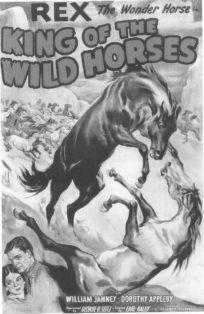
The serial work producer Nat Levine was doing was extremely popular. Audiences flocked to theaters each week to find out how cowboy heroes like Johnny Mack Brown, Ken Maynard, and Tom Mix fared against the bad guys and to learn if equine stars like Rex, the King of Wild Horses, and canine actor Rin Tin Tin managed to save their pal Smiley Burnette from the villainous Harry Woods. Levine wanted to expand his moviemaking and looked to acquire the Mack Sennett production lot and facilities in order to make it happen. He approached Monogram Pictures’ executives Trem Carr and W. Ray Johnston about a merger. Neither was interested in combining his resources to purchase Mack Sennett. Both men felt the cost to run such a business would be too much to sustain. Yates heard about Levine’s proposal and offered to finance the deal. With Yates’ considerable wealth behind the enterprise and the promise that the two could share the responsibility of studio chief, Carr and Johnston decided to participate. The owners of Liberty and Majestic Studios also agreed to merge with Mascot and Monogram. The talent and resources of each small motion picture company were pooled and a distribution arm was also added to the corporation.
Republic Pictures was born in June 1935. As the money behind the venture, Yates wasted no time in asserting his authority. Although Johnston and Carr were installed as managers, Yates made it clear that he would make all major decisions regarding the company. The two executives were outraged by the mogul’s behavior but were compelled to stay with the new studio because they now lacked the means to start their own business. Nat Levine clashed with Yates, too, but chose to keep quiet in favor of making movies. He churned out a number of modest yet successful films during the first four years Republic was in operation.
Undeterred by the conflicts with his managing staff, Yates announced in a press conference with his top personnel that Republic Pictures would produce fifty-two films a year. Edward A. Golden, general sales manager for the studio, added that the company would strive to make exceptional pictures and cited problems with finances in the industry as a whole for the reason some companies delivered inferior products. Johnston shared his belief that not only financing played a part but that the lack of quality material was a contributing factor to bad movies being made. Johnston outlined Republic Pictures’ program to produce classics and the works of famous authors and urged American authors to “write better stories for screen production.”
Throughout the summer of 1935, Republic Pictures and its qualified staff made news. Stories about the ambitious independent studio’s line of pictures and the controversial comments about the industry appeared on the front pages of the newspapers. Johnston, an actor in his early days in Hollywood and a member of Franklin Roosevelt’s motion picture code authority, had definite thoughts about the salary lead actors at Republic should expect to earn. “Stars of today are paid according to their drawing power,” he told the Associated Press. “What they get is all right if they bring it back through the box office. Many of them don’t do that, however. We at Republic Pictures will pay according to the draw.”

To learn more about the many films Republic Pictures produced read
Cowboys, Creatures and Classics: The Story of Republic Pictures

